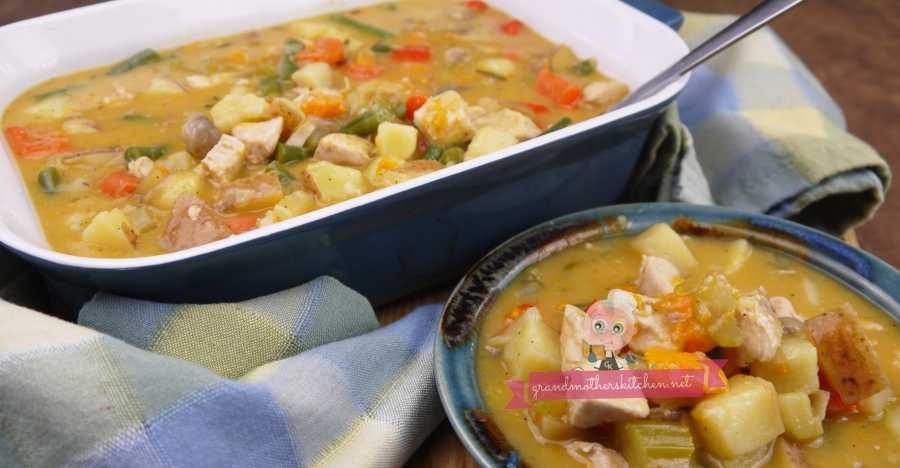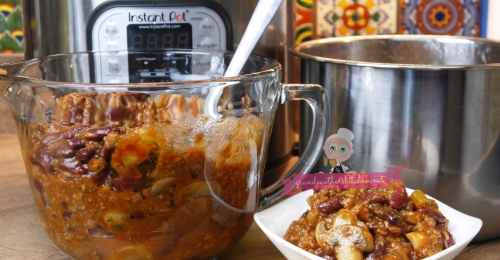Chicken Stew

About this Recipe
Stews are very popular. Beef is a common choice, but for those that prefer chicken, we know you are going to appreciate this Chicken Stew Recipe. We have used the breast meat from the chicken in our version, and this is just our personal preference, but you could also use thighs. The main thing is to make sure you make the chicken meat appealing. In our family, we are quite particular, so that means cutting off parts of the chicken such as tendons, fat and sinew. We have found using a pair of kitchen scissors is the very easiest method to cutting up poultry. The addition of the fresh herbs to this dish may require some altering depending if you have family members that dislike certain herbs. If you need to substitute or remove the herbs from this recipe, not to worry, it will still be delicious!
Grandmother's Kitchen Tips for Chicken Stew:
1. If you love to use fresh herbs in your cooking, we suggest when you purchase them by the bundle, give them a wash, shake dry, then place in a container with water and keep the herbs refrigerated, just like cut flowers they will last a long time in a cool place.
2. When working with carrots, if they are organic and the outsides are nice, just wash and slice, don't bother to peel the carrots, but if they are non-organic and the skins are tough, definitely peel before using.
3. Red potatoes will hold together more than a russet potato, so keep that in mind. You can use any potato you like in the stew, but a russet potato will break down and become softer in the the stew, much like the yam does.
4. If there are items you don't care for in the ingredient list you can omit them. The red bell pepper gives a sort of sweetness to the stew and some adults and children do not care for cooked peppers in their meals. When cooking for you family, if you want them to eat what you have cooked, and you are already aware there are certain foods they are not going to touch, you can always omit those items. Stews are wonderful in that way. You can add extra of things you love and make substitutions. Tastes change all the time and it is good to encourage children to try new flavors with a little 'bite' here and there rather than loading up their dish with things they are going to reject and cause a battlefield at the dinner table.
5. You can serve the stew same day you cook it or you can let cool to room temperature and refrigerate. Most stews are even better on the second day as that gives lots of times for the flavors to infuse.
Making a chicken stew is best with fresh vegetables and meat. You definitely don’t want any of your ingredients to have mold on them either. If you spot some of the white or green fuzzy stuff growing all over your food, dispose of it in the garbage and take the garbage out right away, so it doesn’t spread. Even though mold spores can live anywhere, they prefer moist and dark environments and food too. Organic items are the perfect place for mold, and it’s actually part of the decomposition cycle too. So moldy food is also essentially rotting or expired food, meaning that it’s not at its prime for consumption. It’s recommended to eat fresh food that is full of its natural vitamins and minerals.
Ingredients
Makes 12 - one cup portions
2 chicken breasts (about 6 ounces), cut into small bite sized pieces
3 Tablespoons olive oil, divided
1 medium white onion, diced
1 garlic clove, chopped fine
2 stalks celery, cut into 1/2 inch slices
2 carrots, either washed or peeled and cut into 1/2 inch round slices
3 medium size red potatoes, washed and cut into bite size cubes, do enough to make 4 cups worth ( put the prepared potatoes into a bowl and cover the potatoes with cold water to keep from browning) We used Albert Bartlett potatoes, you can substitute whatever potato you would like to use
1 medium sized yam, peeled and cut into cubes (2 cups worth)
2 cups fresh small mushrooms, washed
1 red bell pepper, cut into large chunks, seeds removed
2 cups fresh green beans, cut into pieces about 1 1/2 inches long
1 cup water
4 cups chicken broth (946ml tetra pack) We used Pacific Brand
5 Tablespoons all purpose flour, divided
1/2 cup cream
1 teaspoon salt
1 teaspoon pepper
1 5-inch sprig of fresh rosemary
3 sprigs fresh thyme
3 sage leaves
Directions
1. You will be using a large Dutch oven. Prepare the ingredients, washing all the vegetables to begin with.
2. Cut up the chicken with scissors into bite sized cubes. Cut off the parts of the chicken such as tendons, fat and sinew. Place the chicken cubes into a bowl and set aside.
3. Dice the onion. Chop the garlic into small pieces. Cut the celery into pieces about 1/2 inch thick. Cut the carrots into pieces about 1/2 inch thick. Peel the carrots if they are not organic. Cut the potatoes into bite size pieces and place into a bowl. Cover the potatoes with cold water to keep them from turning dark. Peel and cut the yam into bite sized pieces. Wash and dry the mushrooms. Cut the red pepper into big chunks, removing the seeds and the stem. Cut the green beans into pieces 1 1/2 inches long.
4. Have the herbs ready. We used one 5-inch sprig of rosemary, 3 sprigs of thyme and 3 sage leaves.
5. Heat up the Dutch oven on medium low, add the oil.
6. Transfer the chicken pieces into something like a pie plate. Sprinkle one tablespoon of flour onto the chicken pieces and gently toss using spoons to lightly coat the chicken.
7. Toss the chicken pieces into the heated oil and cook on medium heat until the chicken is lightly browned and mostly cooked through. Stir often using a metal flipper. You need to keep scraping the browned bits off the bottom of the pan and keep them from burning. They add a lot of flavor to the stew, so keep and eye and keep stirring and flipping while the chicken is cooking. Once the chicken is ready, transfer it back into the pie plate.
8. Meanwhile, while the chicken is cooking in a deep glass measuring cup put one cup broth, the cream, flour,salt and pepper together. Use a hand immersion blender to mix well. Using an immersion blender pretty much assures you will not have lumps in the gravy, but if you do not have an immersion blender, you can put the ingredients into a large jar that has a lid and shake vigorously to combine. Set aside until the very end.
9. Once you have transferred the chicken out of the Dutch oven, add one tablespoon olive oil to the pot. Add the onions and cook a few minutes until tender. Keep scraping the brown bits off the bottom with the metal flipper.
10. Add the garlic, stir in cook another minute.
11. Add the celery and the carrots and cook another 2-3 minutes to soften. Keep stirring, scraping from the bottom.
12. Add the remaining 3 cups of chicken broth and stir in.
13. Add the potatoes, yams and mushrooms. Stir in.
14. Transfer the cooked chicken cubes back into the pot. Stir in. Add the fresh herbs. Give a stir to the pot then cover with a lid, and turn up the heat to high. Uncover, add one more cup of water, stir, then put the lid back on and bring to a boil. One the pot starts to boil, turn it down right away, stir, cover again and then let the stew simmer for 30 minutes.
15. Now,stir in the red peppers and let the stew simmer for 10 more minutes covered.
16. Finally, stir in the green beans and simmer another 10 minutes.
17. Uncover the pot, add the broth/flour mixture, use tongs to remove the any large stems from the rosemary and thyme and the sage leaves. Stir, bring to a boil, then turn back down and cook another 3 minutes.
18. Shut off and let the stew sit 15-20 minutes before serving so the flavors will infuse.
19. Do a taste test for seasonings. We found it just right as it was, but you can season to your personal taste.
20. Serve.
ENJOY!
Return to this Chicken Stew recipe or check out more recipes at Grandmother's Kitchen
After making a big batch of stew, your pot is probably going to be looking fairly messy. So if you want to learn how to clean pots and pans the easy way, look no further. Of course, soaking them really helps if you have the time for that. Just add some dish soap and hot water to the pot and allow it to sit for a few hours or even overnight. Then come back to it and wipe away all of the mess.
You can also put your pot in the dishwasher and allow it to do all of the work for you. Depending on how messy your pot is, it might not come out entirely clean the first time through which means you might have to scrub those tough spots by hand. That’s okay, just try using some baking soda mixed with water as a powder cleanser. It will help loosen the food and make it much easier for you to get it off. Plus it’s all natural.
Definition of Stew To stew means to cook food gently in liquid. This is generally associated with meat and poultry, but you can also make a fish, vegetable or fruit stew. Usually, inexpensive cuts of meat are more tender and have more flavor if they are cooked for long periods of time over lower temperatures. Often marbled meats are chosen for stews because the fat makes the meat more succulent.
What Are The Types Of Stew? Stews can be both white or brown. In white stew which is also called a fricassee, rather than brown the meat, it is blanched to whiten it. This also removes strong flavors. The liquid is generally thickened at the end after the meat has cooked. Irish Stew is an example of this where the potatoes are softened to thicken the gravy. White stews are usually cooked on the stove top. Brown stews are also sometimes referred to as ragout. Before the stock is added to the pot, the meat is first browned and flour is stirred into the meat as it is browning. Vegetables can also be stirred in before the liquid is added. In the case of using meat, it is suggested that you keep it at a simmering point rather than boiling to keep the meat more tender.
References: Grand Diplome Cooking Course (1972, Hardcover), William Anne. Danbury Press.







